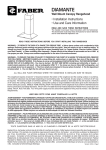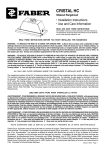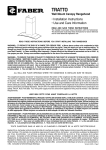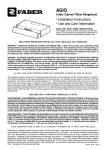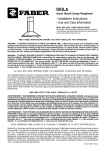Download Faber Pro Magnum Wall Hood
Transcript
PRO MAGNUM Wall Mount Canopy Rangehood • Installation Instructions • Use and Care Information READ AND SAVE THESE INSTRUCTIONS The Installer must leave these instructions with the homeowner. The homeowner must keep these instructions for future reference and for local electrical inspectors' use. READ THESE INSTRUCTIONS BEFORE YOU START INSTALLING THIS RANGEHOOD WARNING: - TO REDUCE THE RISK OF A RANGE TOP GREASE FIRE: a) Never leave surface units unattended at high settings. Boilovers cause smoking and greasy spillovers that may ignite. Heat oils slowly on low or medium setting. b) Always turn hood ON when cooking at high heat or when flambeing food (i.e. Crepes Suzette, Cherries Jubilee, Peppercorn Beef Flambé). c) Clean ventilating fans frequently. Grease should not be allowed to accumulate on fan or filter. d) Use proper pan size. Always use cookware appropriate for the size of the surface element. WARNING: - TO REDUCE THE RISK OF INJURY TO PERSONS IN THE EVENT OF A RANGE TOP GREASE FIRE, OBSERVE THE FOLLOWING: SMOTHER FLAMES with a close-fitting lid, cookie sheet, or metal tray, then turn off the burner. BE CAREFUL TO PREVENT BURNS. If the flames do not go out immediately EVACUATE AND CALL THE FIRE DEPARTMENT. NEVER PICK UP A FLAMING PAN - You may be burned. DO NOT USE WATER, including wet dishcloths or towels - a violent steam explosion will result. Use an extinguisher ONLY if: 1. You know you have a Class ABC extinguisher, and you already know how to operate it. 2. The fire is small and contained in the area where it started. 3. The fire department is being called. 4. You can fight the fire with your back to an exit. ALL WALL AND FLOOR OPENINGS WHERE THE RANGEHOOD IS INSTALLED MUST BE SEALED. This rangehood requires at least 24" of clearance between the bottom of the rangehood and the cooking surface or countertop. This minimum clearance may be higher depending on local building code. For example, for gas ranges, a minimum of 30" may be required. The maximum depth of overhead cabinets is 13". Overhead cabinets on both sides of this unit must be a minimum of 18" above the cooking surface or countertop. Consult the cooktop or range installation instructions given by the manufacturer before making any cutouts. MOBILE HOME INSTALLATION The installation of this rangehood must conform to the Manufactured Home Construction and Safety Standards, Title 24 CFR, Part 3280 (formerly Federal Standard for Mobile Home Construction and Safety, Title 24, HUD, Part 280). Four wire power supply must be used and the appliance wiring must be revised. See Electrical Requirements. LISEZ BIEN CETTE FICHE AVANT D'INSTALLER LA HOTTE AVERTISSEMENT - POUR MINIMISER LE RISQUE D’UN FEU DE GRAISSE SUR LA TABLE DE CUISSON : a) Ne jamais laisser un élément de la table de cuisson fonctionner sans surveillance à la puissance de chauffage maximale; un renversement/ débordement de matière graisseuse pourrait provoquer une inflammation et le génération de fumée. Utiliser toujours une puissance de chauffage moyenne ou basse pour le chauffage d’huile. b) Veiller à toujours faire fonctionner le ventilateur de la hotte lors d’une cuisson avec une puissance de chauffage élevée ou lors de la cuisson d’un mets à flamber (i.e. Crepes Suzette, Cherries Jubilee, Peppercorn Beef Flambé). c) Nettoyer fréquemment les ventilateurs d’extraction. Veiller à ne pas laisser de la graisse s’accumuler sur les surfaces du ventilateur ou des filtres. d) Utiliser toujours un ustensile de taille appropriée. Utiliser toujours un ustensile de taille adapté à la taille de l’élément chauffant. AVERTISSEMENT: - POUR PRÉVENIR LES BLESSURES EN CAS DE FEU SUIVRE LES RECOMMANDATIONS SUIVANTES: ÉTOUFFEZ LE FEU avec un couvercle métallique et fermez le brûleur. Si le feu ne s'éteint pas tout de suite, QUITTEZ LES LIEUX ET APPELEZ LES POMPIERS. NE TOUCHEZ JAMAIS UNE CASSEROLE EN FLAMMES. N'UTILISEZ JAMAIS DE L'EAU ou un torchon mouillé pour éteindre le feu - ce qui pourrait causer une explosion de vapeur. N'utilisez un extincteur que si: 1. Vous avez un modèle ABC et vous connaissez bien son mode d'emploi. 2. Le feu est petit et peu répandu. 3. Les pompiers sont déjà prévenus. 4. Vous avez une sortie derrière vous. TOUTE OUVERTURE DANS LE MUR OU LE PLANCHER À PROXIMITÉ DE LA HOTTE DOIT ÊTRE SCELLÉ Gardez 24 po. de hauteur entre le bas de la hotte et la surface de cuisson. Cette hauteur minimum peut être plus haute suivant le code municipal. Par exemple, les cuisinières à gaz peuvent requérir 30 po. de hauteur. Les armoires au-dessus ne dépasseront pas 13 po. de profondeur. Les armoires au-dessus de chaque côté devront être au moins à 18 po. au-dessus de la surface de cuisson. Consultez la fiche technique avant de découper les armoires. L'installation de cette hotte doit être conforme aux Réglements de Manufactured Home Construction and Safety Standards, titre 24 CFR, Section 3280 (anciennement Federal Standard for Mobile Home Construction and Safety Standards, titre 24 CFR, Section 3280 (anciennement Federal Standard for Mobile Home Construction and Safety, titre 24, HUD, Section 280). Le branchement électrique se fait avec une raccordement à 4 fils. Consultez la fiche technique électrique. Version 12/04 - Page 1 VENTING REQUIREMENTS Determine which venting method is best for your application. Ductwork can extend either through the wall or the roof. The length of the ductwork and the number of elbows should be kept to a minimum to provide efficient performance. The size of the ductwork should be uniform. Do not install two elbows together. Use duct tape to seal all joints in the ductwork system. Use caulking to seal exterior wall or floor opening around the cap. This appliance should be connected directly to the fused disconnect (or circuit breaker) through flexible, armored or nonmetallic sheathed copper cable. Allow some slack in the cable so the appliance can be moved if servicing is ever necessary. A UL Listed, 1/2" conduit connector must be provided at each end of the power supply cable (at the appliance and at the junction box). When making the electrical connection, cut a 1 1/4" hole in the wall. A hole cut through wood must be sanded until smooth. A hole through metal must have a grommet. Flexible ductwork is not recommended. Flexible ductwork creates back pressure and air turbulence that greatly reduces performance. WARNING - TO REDUCE THE RISK OF FIRE OR ELECTRIC SHOCK, do not use this fan with any solid-state speed control device. Make sure there is proper clearance within the wall or floor for exhaust duct before making cutouts. Do not cut a joist or stud unless absolutely necessary. If a joist or stud must be cut, then a supporting frame must be constructed. WARNING - TO REDUCE THE RISK OF FIRE, ELECTRICAL SHOCK, OR INJURY TO PERSONS, OBSERVE THE FOLLOWING: Use this unit only in the manner intended by the manufacturer. If you have any questions, contact the manufacturer. FOR MORE SPECIFIC DUCTWORK INFORMATION, GO TO PAGE 4. WARNING - To Reduce The Risk Of Fire, Use Only Metal Ductwork. ! WARNING • Venting system MUST terminate outside the home. • DO NOT terminate the ductwork in an attic or other enclosed space. • DO NOT use 4" laundry-type wall caps. • Flexible-type ductwork is not recommended. • DO NOT obstruct the flow of combustion and ventilation air. • Failure to follow venting requirements may result in a fire. ELECTRICAL REQUIREMENTS A 120 volt, 60 Hz AC-only electrical supply is required on a separate 15 amp fused circuit. A time-delay fuse or circuit breaker is recommended. The fuse must be sized per local codes in accordance with the electrical rating of this unit as specified on the serial/rating plate located inside the unit near the field wiring compartment. THIS UNIT MUST BE CONNECTED WITH COPPER WIRE ONLY. Wire sizes must conform to the requirements of the National Electrical Code, ANSI/NFPA 70 - latest edition, and all local codes and ordinances. Wire size and connections must conform with the rating of the appliance. Copies of the standard listed above may be obtained from: National Fire Protection Association Batterymarch Park Quincy, Massachusetts 02269 Before servicing or cleaning unit, switch power off at service panel and lock the service disconnecting means to prevent power from being switched on accidentally. When the service disconnecting means cannot be locked, securely fasten a prominent warning device, such as a tag, to the service panel. CAUTION: For General Ventilating Use Only. Do Not Use To Exhaust Hazardous or Explosive Materials and Vapors. WARNING - TO REDUCE THE RISK OF FIRE, ELECTRICAL SHOCK, OR INJURY TO PERSONS, OBSERVE THE FOLLOWING: Installation Work And Electrical Wiring Must Be Done By Qualified Person(s) In Accordance With All Applicable Codes And Standards, Including Fire-Rated Construction. Sufficient air is needed for proper combustion and exhausting of gases through the flue (chimney) of fuel burning equipment to prevent backdrafting. Follow the heating equipment manufacturer's guideline and safety standards such as those published by the National Fire Protection Association (NFPA), and the American Society for Heating, Refrigeration and Air Conditioning Engineers (ASHRAE), and the local code authorities. When cutting or drilling into wall or ceiling, do not damage electrical wiring and other hidden utilities. Ducted fans must always be vented to the outdoors. ! WARNING • Electrical ground is required on this rangehood. • If cold water pipe is interrupted by plastic, nonmetallic gaskets or other materials, DO NOT use for grounding. • DO NOT ground to a gas pipe. • DO NOT have a fuse in the neutral or grounding circuit. A fuse in the neutral or grounding circuit could result in electrical shock. • Check with a qualified electrician if you are in doubt as to whether the rangehood is properly grounded. • Failure to follow electrical requirements may result in a fire. For residential use only. Version 12/04 - Page 2 RÈGLEMENTS D'ÉVACUATION Confirmer la sortie d'évacuation - soit par le mur, soit par le toit. Utilisez une longueur de tuyauterie minimale avec les moindres de coudes pour la plus grande efficacité. Le diamètre de tuyauterie doit être uniforme. N'installez jamais 2 coudes ensemble. Scellez bien tous les joints avec un ruban adhésif métallique à l'intérieur et scellez bien le clapet extérieur avec du calfeutrage. Utilisez un tuyau d'évacuation rigide lorsque possible. Un tuyau flexible égale deux fois plus qu'un tuyau rigide, ce qui réduit la puissance d'évacuation. Un conduit d'évacuation flexible crée une contre-pression et une turbulence de l'air qui réduisent considérablement la performance. Veillez à ce que l'espace pour le tuyau soit ample - ainsi on n'aurait pas besoin de découper les supports de mur intérieur. Si ce découpage est nécessaire, veillez bien à ce qu'un renforcement soit mis en place. RÈGLEMENTS D'ÉVACUATION ADDITIONELL - PAGE 8. AVERTISSEMENT - Pour Ne Pas Risquer Un Feu, Utilisez Seulement Les Matériaux Métalliques. ! AVERTISSEMENT • Le système d'évacuation DOIT sortir à l'extérieur. • N'ÉVACUEZ PAS le conduit soit dans une mansarde soit dans un espace enfermé. • N'UTILISEZ PAS un clapet de séchoir à 4 pouces. • N'utilisez pas un conduit flexible. • N'ENCOMBREZ PAS la circulation d'air. • Faute de suivre cet avertissement pourrait occasionner un feu. FICHE TECHNIQUE ÉLECTRIQUE Le raccordement électrique doit se faire avec un circuit séparé de 15 ampères fusible à 120V, 60 Hz, courant alternant. On recommande un coupe-circuit. La taille du fusible doit se conformer aux codes municipaux suivant la spécification électrique sur la plaque intérieure. Le diamètre du fil devra aussi se conformer aux règlements du code national électrique, ANSI/NFPA 70 - ainsi qu'aux règlements locaux et les spécifications de cet appareil. On peut obtenir ces informations chez: l'Association Nationale de la Prévention du Feu Batterymarch Park Quincy, Massachusetts 02269 Raccordez cet appareil directement au coupe-circuit avec un fil flexiblle couvert en cuivre en laissant un peu de lâchement dans le fil pour permettre le déplacement de l'appareil. Veillez a ce qu'un contact d'un demi-pouce (1/2 po.) soit installé à chaque bout de fil (soit à l'appareil ainsi qu'à la boite à fusible). Faites un trou de 1 1/4 po. dans le mur. S'il s'agit d'un trou en bois - sablez-le bien, tandis qu'un trou passant par le métal demande un bouche-trou. AVERTISSEMENT - POUR RÉDUIRE LE RISQUE D'INCENDIE OU DE CHOC ELECTRIQUE, ne pas utiliser ce ventilateur en conjonction avec un dispositif de réglage de vitesse à semi-conducteurs. AVERTISSEMENT – POUR MINIMISER LES RISQUES D’INCENDIE, CHOC ÉLECTRIQUE OU DOMMAGES CORPORELS, OBSERVER LES PRESCRIPTIONS SUIVANTES: Suivez les recommandations du fabricant et entre en communication avec lui pour toute information. Fermez le courant avant tout entretien et veillez a ce qu'il reste fermé. Si on ne peut pas verrouiller le panneaux du service électrique, affichez un avis de danger sur la porte. AVIS: Pour L'évacuation Générale - Veillez à Ne Pas Evacuer Des Matériaux Ou Vapeurs Explosif. AVERTISSEMENT – POUR MINIMISER LES RISQUES D’INCENDIE, CHOC ÉLECTRIQUE OU DOMMAGES CORPORELS, OBSERVER LES PRESCRIPTIONS SUIVANTES: L'installation Et Le Raccordement Electrique Doivent Se Faire Par Un Technicien Qualifié Selon Tous Les Codes Municipaux. Afin d'obtenir un rendement maximal en ce qui a trait à la combustion ainsi qu'à l'évacuation des gaz par la conduite de cheminée, une bonne aération est nécessaire pour tous les appareils à combustion. Suivez les conseils et mesures de sécurité du fournisseur tels que ceux publiés par l'Association Nationale de la Sauvegarde contre l'Incendie et l'Association Américaine d'Ingénieurs de Chauffage, Frigorifaction et Air Climatisé ainsi que les codes municipaux. En perçant un mur veillez à ne pas perforer un autre fil électrique. Une ventilateur à évacuation extérieure doit être raccordée à l'extérieur. ! AVERTISSEMENT • Une prise à terre est nécessaire pout cette hotte. • N'utilisez pas un tuyau à l'eau froide pour la mise à terre s'il est branché à un joint plastique, nonmétallique ou autre. • NE JOIGNEZ PAS la mise à terre à conduit de gaz. • N'INSTALLEZ PAS un fusible dans le circuit de mise à terre - ce qui peut causer une secousse électrique. • Vérifiez avec un électricien certifié à ce que la hotte soit bien mise à terre. • Faute de suivre ces recommandations pourrait occasionner un feu. Uniquement pour usage menager. Version 12/04 - Page 3 TOOLS NEEDED FOR INSTALLATION • Saber Saw or Jig Saw • Drill • 1 1/4" Wood Drill Bit • Pliers • Phillips Screwdriver • Flat Blade Screwdriver • Wire Stripper or Utility Knife • Metal Snips • Measuring Tape or Ruler • Level • Pencil • Caulking Gun • Duct Tape PARTS SUPPLIED FOR INSTALLATION • 1 Hardware Package • 1 Literature Package PARTS NEEDED FOR INSTALLATION • 2 Conduit Connectors • Power Supply Cable • 1 Wall or Roof Cap • All Metal Ductwork OPTIONAL ACCESSORIES AVAILABLE • 30" High Backsplash 30" high, mounts to the wall beneath the rangehood for a coordinated look part # 620000095 - 30" model part # 620000097 - 36" model part # 620000098 - 48" model • Telescopic Chimney Kit (FIGURE 3) 24" wide, extends to accomodate 8 - 9 foot ceilings part # 6097336 fits all size hoods • Full Width Duct Cover (FIGURE 4) 12" high, extends full width of the hood part # 6097337 - 30" model part # 6097338 - 36" model part # 6097339 - 48" model • Duct Transition Kit For 48" model only, optional kit transitions two 3 1/4" x 10" openings to one 10" round opening part # 6000002 • *Charcoal Filters * it is highly recommended that professional style cooking always be vented to the outside; for recirulating installations, some ductwork is required to exhaust the unit out of the cabinet. For 48" model, order 2 kits, one for each motor. part # 6093034 CALCULATE THE DUCTRUN LENGTH The ductrun should not exceed 35 equivalent feet if ducted with the required minimum of 3 1/4" by 10" rectangular duct or 55 equivalent feet if ducted with 10" round duct (when using Duct Transition Kit for 48” model only). Calculate the length of the ductwork by adding the equivalent feet in FIGURE 1 for each piece of duct in the system An example is given in FIGURE 2. For best results, use no more than three 90° elbows. Make sure that there is a minimum of 24" of straight duct between elbows if more than one is used. Do not install two elbows together. If you must elbow right away, do it as far away from the hood's exhaust opening as possible. 45˚ Elbow 90˚ Elbow 90˚ Flat Elbow Wall Cap 3.0 feet 5.0 feet 12.0 feet 0.0 feet FIGURE 1 9 Feet Straight Duct 9.0 feet 2 - 90˚ Elbows 10.0 feet Wall Cap 0.0 feet Total System 19.0 feet FIGURE 2 WARNING ! PERSONAL INJURY HAZARD Due to the weight and size of the rangehood canopy, two or more people are needed to move and safely install the rangehood canopy. Failure to properly lift rangehood could result in damage to the product or personal injury. PLAN THE INSTALLATION This rangehood can be vented through the wall or ceiling. To vent through a wall, the blower must be turned to vent to the rear. This rangehood can be installed with two different chimney options as well as without a chimney. Before you begin installation, you must determine which chimney installation will be used. The Telescopic Chimney Kit is adjustable and designed to meet varying ceiling heights from 8 to 9 feet. FIGURE 3 illustrates the dimensions of the rangehood with the optional Telescopic Chimney Kit. FIGURE 4 illustrates the dimensions of the rangehood with the optional Full Width Duct Cover. The body of the rangehood is the same dimensions regardless of the chimney option used. WARNING! BEFORE MAKING ANY CUTS OR HOLES FOR INSTALLATION, DETERMINE WHICH VENTING METHOD AND CHIMNEY WILL BE USED AND CAREFULLY CALCULATE ALL MEASUREMENTS. RANGEHOOD WITH FULL WIDTH DUCT COVER RANGEHOOD WITH TELESCOPIC CHIMNEY KIT 25" 25" FIGURE 3 FIGURE 4 Version 12/04 - Page 4 PREPARE THE WALL 1. Disconnect and move freestanding range from cabinet opening to provide easier access for installation. Put a thick, protective covering over cooktop, set-in range or countertop to protect from damage or dirt. 2. Determine and clearly mark with a pencil the center line on the wall where the rangehood will be installed. 3. The Pro Magnum attaches to the wall by mounting screws indicated in FIGURE 5. For the 30" and 36" models, there are two mounting screws. For the 48" model, there are four mounting screws. Install the screws into the wall. The screws should be inserted into the wall until the screw head is flush with the wall. WARNING: THE SCREWS PROVIDED FOR MOUNTING THIS RANGEHOOD MUST BE INSERTED INTO SOLID WOOD. THESE MUST NOT BE INSERTED INTO SHEET ROCK. If a backsplash is to be used with this rangehood, it must be installed before the rangehood. Installation instructions for the backsplash are supplied in its box. The height of the backsplash will determine the bottom edge of the canopy. FIGURE 7 Determine the proper location for each bracket and install the brackets on the wall. MAKE SURE THAT THE SCREWS AND BRACKETS ARE SECURELY FASTENED TO THE WALL. 5. Determine and make all necessary cuts in the wall for the ductwork. The Pro Magnum vents either through the top or the rear of the rangehood. Each rangehood is shipped from the factory vented through the top. In order to vent to the rear, the blower inside the rangehood must be turned to the rear. The dimensions for the duct openings are given in FIGURE 8. The 48" model uses two 3 & 1/4" by 10" duct openings. Install all ductwork before installing the rangehood. 6. Determine the proper location for the Power Supply Cable as indicated in FIGURE 8. Note that the 30"/36" versions have the option of top or rear electrical connection while the 48" version has only the rear option. Use a 1 & 1/4" Drill Bit to make this hole. Run the Power Supply Cable. Use caulking to seal around the hole. DO NOT turn on the power until installation is complete. 30" AND 36" VERSIONS FIGURE 5 4. The Telescopic Chimney Kit and Full Width Duct Cover use different bracket systems to attach to the wall. FIGURE 6 provides the position for the telescopic chimney brackets. Electrical Opening 48" VERSION FIGURE 6 FIGURE 7 provides the dimensions for the Full Width Duct Cover brackets. The Full Width Duct Cover also attaches to the top of the rangehood with screws provided. The Full Width Duct Cover must be attached to the top of the rangehood before mounting the rangehood to the wall. Electrical Opening FIGURE 8 Version 12/04 - Page 5 INSTALL THE RANGEHOOD 1. Remove the unit from the carton and place on a flat surface for assembly. Cover the surface to prevent accidental damage. Remove all parts including the mounting hardware before discarding the carton. 2. Remove the grease filters USING TWO HANDS (one to hold the filter so that it doesn't fall on cooktop and one to turn the knob) by pulling the knob out and turning to the left. 3. The rangehood is shipped from the factory in the up vent position as indicated in FIGURE 9. For top vent applications, no additional adjustments are necessary. FIGURE 11 6. Install the damper before hanging the rangehood. The damper attaches to the rangehood by two small screws provided in the hardware package. If 48" hood is to be connected to 10" round duct, install the Duct Transition Kit now. FIGURE 9 For rear vent applications, the blower must be turned inside the rangehood so that the blower vents to the rear as indicated in FIGURE 10. The blower is turned by removing two screws on each side of the blower, rotating the blower with the exhaust opening facing the rear and then replace the screws. The exhaust cover must be moved to block the unused opening. The blower must be converted before installing the rangehood. FIGURE 10 4. Remove the cover from the field wiring compartment. Remove the wiring electrical knockout using a flat-blade screwdriver. Feed the Power Supply Cable through the electrical knockout. 5. The canopy attaches to the wall by two screws discussed earlier in the installation instructions. The canopy hangs from these screws by brackets inside the rangehood shown in FIGURE 11. Before attempting to hang the canopy, you should rotate the adjustment screw marked V1 in FIGURE 11 counterclockwise to extend the brackets from the canopy. Using a Phillips head screwdriver, rotate this screw counterclockwise to extend the bracket. 7. Hang the rangehood canopy from the screws. Due to the weight of the canopy, these screws must be installed into solid material! Once the canopy is hung, rotate the screw marked V1 to secure the rangehood to the wall. MAKE SURE THAT THE RANGEHOOD IS SECURELY ATTACHED TO THE WALL! FAILURE TO PROPERLY INSTALL COULD RESULT IN INJURY OR DAMAGE TO PROPERTY. 8. The brackets shown in FIGURE 11 are also used to adjust the level of the canopy. Using a Phillips screwdriver, rotate the screw V2 to adjust the level of the canopy. 9. Connect the Power Supply Cable to the rangehood. Attach the White lead of the power supply to the White lead of the rangehood with a twist-on type wire connector. Attach the Black lead of the power supply to the Black lead of the rangehood with a twist-on type wire connector. Connect the Green ( Green and Yellow ) ground wire under the Green grounding screw. 10. Replace the field wiring compartment cover and the grease filters. 11. If the installation uses a telescopic chimney, connect the ductwork and install the chimney. Mount the upper chimney section to the wall first. Then mount the lower section. The lower section fits over the upper section. If the installation uses a full width duct cover, install it now. 12. Turn the power supply on. Turn on blower and light. The rangehood controls are located on the right-hand side under the canopy. If the rangehood does not operate, check that the circuit breaker is not tripped or the house fuse blown. If the unit still does not operate, disconnect the power supply and check that the wiring connections have been made properly. Version 12/04 - Page 6 WARRANTY & SERVICE USE AND CARE INFORMATION All Faber products are warranteed against any defect in materials or workmanship for the original purchaser for a period of 1 year from the date of original purchase. This warranty covers labor and replacement parts. The warranty does not cover consumable parts such as filters and light bulbs. This warranty does not apply if this product has been subjected to faulty installation, misuse, or neglect. This warranty excludes any consequential expense or damage resulting from any use or malfunction of the product. All implied warranties are limited to the duration of this warranty. This rangehood system is designed to remove smoke, cooking vapors and odors from the cooktop area. To obtain warranty service, contact the dealer from whom you purchased the rangehood, or the local Faber distributor. If you cannot identify a local Faber distributor, contact us at (508) 358-5353 for the name of a distributor in your area. WIRING DIAGRAM FOR 30" & 36" MODELS Rangehood Control Panel The control panel is located on the right-hand side under the canopy. The position and function of each control button are indicated in FIGURE 13. 0 1 L 0 1 0 M 1 2 V FIGURE 13 Light On/Off Button ( L ) On/Off switch for the halogen lights. Move the switch to "1" to turn the light ON and to "0" to turn it OFF. Blower On/Off Button ( M ) On/Off switch for the blower. Move the switch to "1" to turn the blower ON and to "0" to turn it OFF. Blower Speed Button ( V ) Speed control for blower. Move the switch to position 1 for LOW Speed, 2 for MEDIUM speed and 3 for HIGH speed. For Best Results Start the rangehood several minutes before cooking to develop proper airflow. Allow the unit to operate for several minutes after cooking is complete to clear all smoke and odors from the kitchen. Cleaning The stainless steel grease filters should be cleaned frequently in hot detergent solution or washed in the dishwasher. Clean exterior surfaces with a commercially available stainless steel cleaner. Abrasives and scouring agents can scratch stainless steel finishes and should not be used to clean finished surfaces. WIRING DIAGRAM FOR 48" MODEL Replacing the Halogen Lamps Before you begin, make sure that the rangehood is turned off and that the other lamps have had sufficient time to cool. Halogen bulbs burn extremely hot and serious injury could result from touching a hot bulb. To replace the lamp, the bezel (A) around the lamp(C) must be removed as indicated in FIGURE 14. This bezel (A) is held in place by two screws (B). Remove the two screws and the bezel. Then remove the lamp and replace with a new lamp. Once the new lamp is in place, reinstall the bezel. FIGURE 14 • This rangehood uses 20 watt Halogen Lamps. Version 12/04 - Page 7







